Insect & Disease Conditions Update
A printer-friendly version of this report is available on-line from the Conditions Report Index.
We are getting on towards the end of the growing
season. Pests found on tree foliage now do little damage as the trees are
shutting down for the winter. It is still dry in the southern half of the State.
This will affect trees that have had pest problems this year as the lack water
is another stressor and makes it more difficult for the trees to overcome
insect or disease damage. In areas without adequate precipitation, water newly
planted trees through the fall.
We note the passing of Maynard Atwood, retired long-time Entomology
Technician in western Maine, who died August 5th http://www.wilescremationcare.com/obituaries/Maynard-Atwood/#!/Obituary.
Maynard originally came to work
for the Maine Forest Service in spring of 1955, working seasonally for Fire
Control. In the spring of 1961 he
transferred to what was then known as the Division of Entomology, just in time
to be involved in the 1961 spruce budworm treatment project in northern
Aroostook County. He continued to work
on survey and management of forest insects and diseases until he retired
in Feb 29, 1984. Although his primary responsibility throughout his career was
monitoring conditions in the Southern District in the Western Region, Maynard
spent a large portion of the last 10 years of his career heavily focused on
spruce budworm management, and back in the northern half of the state.
Even after he retired, he
continued his involvement with our shop, often stopping at the lab when
he was in Augusta and operating a light trap at his home in Kingfield into
the 2016 season. His cheerful demeanor
and ready assistance will be missed.
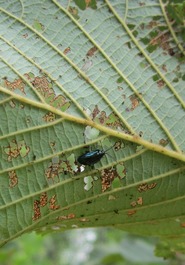 Alder
Flea Beetle (Altica ambiens) – Populations
of alder flea beetle seem to be enjoying a boom. Field technicians in our inventory unit noted
that they needed to close truck windows to avoid larval intrusions to the
passenger cab when travelling roads overarched by alders and several have
noticed and reported the stretches of alder with lacy brown leaves along
roadsides in their travels through Maine.
In his documentation of the biology of the alder flea beetle (MAES Bull.
265, 1917) William C. Woods describes the scene of an outbreak of this species
well: “…By the middle of August practically all of the leaves of every alder
bush…had been skeletonized by the larvae, and the trees looked brown and bare
as though they had been swept by a fire.”
Although infestations have not uniformly reached that level, copses of
alder can be found that fit that description.
This is not an economic pest in Maine, as alder are of little economic
significance.
Photo: Alder flea beetle adult on damaged alder leaf. (MFS
Photo)
Outbreaks
are reported to last two to three years.
Woods noted that the flea beetle prefers to oviposit within the
leaf-rolls created by alder tubemaker moths (Acrobasis rubrifasciella), and noted that a drop in numbers of the
moth coincided with the collapse of the 1912-1915 outbreak of alder flea
beetle. A quick lunch-time search of
alder around the Old Town office revealed some sign of the tubemaker (one frass
tube) and ample evidence of alder flea beetle including damage to foliage and
feeding adults (along with two species of sawfly, woolly alder aphids and two Calligrapha spp. beetle).
|
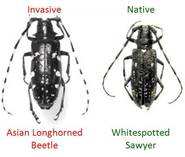
Asian Longhorned Beetle (Anoplophora glabripennis)–
August has been designated “tree check month” by the USDA APHIS, in part
because of the August 2008 detection of Asian longhorned beetle in Worcester,
MA. We are in the period now where we would expect peak emergence of
adult Asian longhorned beetles in Maine if it were here. Asian
longhorned beetle has not been confirmed in Maine. Please take
some time to become familiar with its appearance and the damage it causes so if
it is in Maine we find it early and respond quickly. If you need informational material to
distribute to friends or clients please let us know. You’ll find more
information at www.maine.gov/alb.
Photo: The invasive Asian longhorned beetle (left) and native look-alike (right) (Photo PA DCNR)
|
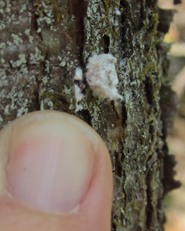 Balsam Woolly Adelgid (Adelges piceae) – Observations have come in from many corners of balsam woolly
adelgid (BWA) populations rebounding.
High density trunk phase populations (those found on the stems of the
tree) have been observed in New Sharon (Franklin County), Rome (Kennebec
County) Bangor (Penobscot County) and Washington County. Populations of moderate density have been
observed in Lincolnville (Waldo County) and Calais (Washington County). Combine current populations with a history of
chronic infestation and the stress of an abnormally dry growing season and you
have a formula for increased fir mortality in Maine’s coastal and interior regions
(http://digitalcommons.colby.edu/cgi/viewcontent.cgi?
article=1002&context=atlas_docs).
Photo: Three wool-covered balsam woolly adelgid (in crevice above
finger) and a predatory green lacewing larva (Chrysopidae) covered with BWA
corpses and other debris (right of BW). (MFS Photo)
|
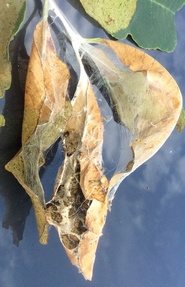 Browntail Moth (Euproctis chrysorrhoea) –
Browntail moth larvae have hatched and are skeletonizing the leaves of oak and
apple trees in the Midcoast region. The infestation will again be severe in
Sagadahoc County and spreading into Freeport, Yarmouth and Falmouth (Cumberland
County). Reports of moths and/or damage have come in from Eliot to Rouque
Bluffs indicating spot infestations may be found anywhere along the coast and
inland as far as Turner (Androscoggin County) and Waterville (Kennebec County).
Photo: Developing overwintering web of browntail moth
caterpillars. Note the
characteristic binding of the leaf stems to the twig with tight
"ropes" of silk (top of photo). This will keep webs fastened to the tree through tough winter
storms, allowing the caterpillars to be right next to their food source
when the buds just start to swell. (MFS Photo)
Look for brown leaves at the
tops of oak and apple right now and leaves wrapped tightly together at the very
tips of oaks and apples once the rest of the leaves have fallen. Consider what
your strategy for next year will be.
|
 Dogwood Sawfly (Macremphytus
spp.) – Dogwood bling? That is how this insect is described by one
University of Illinois extension specialist, http://web.extension.illinois.edu/cfiv/eb294/entry_9063/.
Unless you catch these guys early, it is probably the best way to think
of them. Dogwood flowers bring swarms of
beneficial insects including adult parasitoids and pollinators, so avoiding broad-spectrum
chemical insecticides on this pest is a sensible practice. If you catch the sawflies early, hand picking
and application of horticultural oils or soaps are effective ways to manage
their aesthetic impacts. For early intervention, periodically scout your
dogwood leaves for eggs and the skeletonizing damage from the gregarious young
larvae (photos: http://www.ipm.iastate.edu/ipm/hortnews/2009/8-12/sawfly.html). Dogwoods do tend to survive attacks well so if you miss this window of
opportunity, don’t fret, begin scouting earlier next year. The last instar of this insect wanders in
search of a pupation site in soft wood.
This can create a nuisance for homeowners when that soft wood is siding,
favorite outdoor furniture or very occasionally structural wood—the nuisance can
be compounded by woodpecker activity.
Photo: Dogwood sawfly larvae are invading the top of this deck post in Rangeley, ME. (Photo Courtesy David Fuller, UMaine Coop. Ext.)
|
Emerald Ash Borer (Agrilus
planipennis) – Biosurveillance
for emerald ash borer (EAB) has just finished for the season. We were monitoring for EAB with the
assistance of Cerceris fumipennis, a
helpful (non-stinging) wasp which often lives in baseball diamonds and hunts
the native relatives of EAB as well as EAB when it is present. Wasp numbers in some of our colonies were
down, but we carried out biosurveillance throughout the southern part of the
state where this wasp lives. No EAB were
discovered during this survey, nor has EAB been confirmed in Maine to-date.
Elongate Hemlock Scale (Fiorinia
externa) – Mobile stages of this
pest are still present, so there is still high risk of spreading scale on
clothing and machinery. If you wait
until after a hard frost for forest management and pruning activities, you will
minimize risk of spreading this pest.
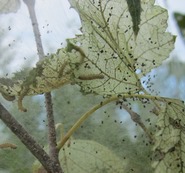 Fall Webworm (Hyphantria
cunea) – The webs of fall
webworm caterpillars are quite visible now; building of the webs was underway
by mid-July but additions will continue until the caterpillars pupate later
this season. Although unsightly, feeding
from this insect does not cause significant damage to its host. If you want to reduce aesthetic impacts it is
best to start looking for this pest in early July. Two low impact ways to reduce aesthetic damage
are to relocate webs or wash them from the tree with a concentrated blast from
a garden hose. Both methods may require follow-up and should be employed when
the webs first begin to form. These webs
are much looser and larger than those of the early larval instars of browntail
moth. Another way to distinguish the
webs is to look at their occupants.
Browntail moth caterpillars are tiny (~ 1/8th inch), the two
bright orange glands on their tail-ends aren’t orange in these early instars,
but they are there as yellow spots. Fall
webworm caterpillars, just like their webs, are larger (>1/2 inch in most
places by now).
Photo: A look inside a nest of fall webworm caterpillars on gray
birch. These larvae were approximately
½” long on August 26th in Old Town, ME. (MFS Photo)
|
Hemlock Woolly Adelgid (Adelges tsugae) – Towards the beginning of August hemlock woolly adelgid
crawlers settle on their hosts and are attached to them for the next six months
or more. Because the adelgid cannot be spread except on rooted hosts, now is an
ideal time to conduct forest management and pruning activities in hemlock. Hemlock woolly adelgid has been confirmed in
Standish (Cumberland County).
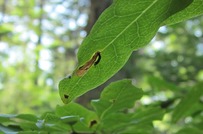 Leaf-miner on Holly
Species (Possibly Rhopobota dietziana) – The mines of a
tortricid leaf-miner and –tier on
holly (Ilex spp.), possibly Rhopobota dietziana, were seen in
abundance in Orono (Penobscot County) and Lincolnville (Waldo County) this
month. Hosts included the understory
shrubs winterberry (Ilex verticillata)
and mountain holly (Ilex mucronata). Although the mining itself was abundant enough to be eye-catching
in places, the “hook” was a small tube of frass extending out of the mine on
the undersurface of affected leaves. At
first glance this resembled spindle-galls found on cherry, but close
examination revealed that the hook was made of digested, not galled, plant
tissue. The moth had already departed
all examined mines and tied leaves.
Photo: Leaf-mine possibly created by Rhopobota dietziana on mountian holly (Ilex mucronata). (MFS Photo)
|
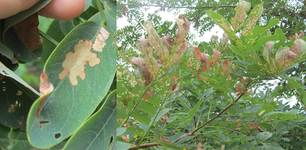
Locust Leaf Miner and Locust Digitate Leafminer (Odontota dorsalis and Parectopa robiniella) – Similarly to the
attention given to the scorched appearance of alders, people have been noting,
some with alarm, the scorched appearance of black locusts. Some locusts appear untouched by damage and
others have scant green leaves. Significant
skeletonizing and mining is being done by a leaf-mining beetle—Odontota dorsalis. However some mines of a delicate moth
species, the locust digitate leafminer, can also be found on the foliage of
affected trees. The previous outbreak of
locust leaf mining beetles in Maine caused branch dieback and some locust
mortality.
Photo: A mine of the locust digitate leafminer, a gracillariid
moth (left) and larval mines and adult skeletonizing damage caused by the
locust leaf miner, a chrysomelid beetle (right), Old Town, ME.
|
Spruce budworm (Choristoneura
fumiferana) – In June the Maine Forest Service distributed spruce budworm
pheromone trapping supplies to over 20 cooperators; more than 35 additional
volunteers received trapping supplies through a MFS cooperator, the Canadian Budworm
Tracker program (www.budwormtracker.ca).
Participants in the Maine Forest Service trap network are just beginning
to send in their catches—early results suggest the number of budworm in traps
may be down this year from previous years.
When full results are in, a report will be available on-line and by
request (expected late-fall 2016 for MFS and early-spring 2017 for Budworm
Tracker Program). Links to these reports
will be provided from www.maineforestservice.gov and www.sprucebudwormmaine.org.
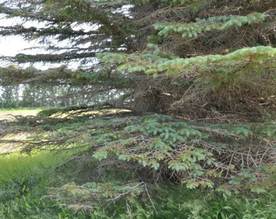
Stigmina and Rhizosphaera
Spruce Needle Cast Diseases (Rhizosphaera
kalkoffii and Stigmina lautii) – Spruce needle cast diseases
are commonly encountered throughout Maine where spruce trees are planted. Needle cast fungi were also recently noticed
during a survey of a naturally forested area in central Maine, although symptom
severity in most instances in the forest was less than typically seen in
landscape situations. The most susceptible host species are Colorado blue
spruce and white spruce, with red, black and Norway spruces showing varied
levels of resistance.
Photo: A tree with needle cast symptoms. Note the lack of needle retention. (Aaron Bergdahl, North Dakota Forest Service)
|
Symptoms and signs of spruce needle cast disease include the following:
-
Needle loss and branch dieback occurring from the bottom up.
- Current-year needles have no visible symptoms, although they are already infected following early spring spore dispersal and will show symptoms next year (1). Needles from the previous year remain attached to the tree and appear discolored (2). Needles from three years ago are typically brown and begin to fall off the fine branches; many of these needles are gone by late summer, while needles from four years ago or older are absent (3+). This loss of older needles causes the lower canopy to appear thin and grayish. (See annotated image, below)
- The tiny spore-producing structures of Stigmina are black, round and fuzzy looking; those of Rhizosphaera are black, round and not fuzzy looking. Both forms of fungal masses grow in orderly rows out of needle pores (stomata) and are visible with a hand lens.
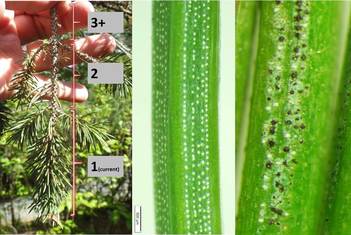 Photos: (Left image) Current-year needles (1) are infected but do
not show symptoms. Second-year needles (2) were infected last year and have
begun to show discoloration, spore producing structures appear on some needles
and some needles are beginning to fall off. The third-year needles (3) have
mostly been cast; the remaining needles contain many spore-producing
structures. Trees heavily infested with needle cast disease fungi will not have
needles on any growth that is older than three years.
(Close-up needle images) (L) A healthy needle and (R) a needle infected with the Stigmina needle cast fungus showing the fuzzy-looking round spore producing structures.
Aaron Bergdahl, North Dakota Forest Service
|
Management of Spruce Needle Cast Diseases
Needle cast diseases require
moisture for infection and spread, so improving spacing and airflow are important
cultural practices for management. Care should be taken to avoid wetting of
foliage during irrigation. Irrigate lawns at night to prevent prolonging
periods of higher relative humidity near landscape trees.
Needles on at least the bottom
half of the crown should be protected with fungicide containing chlorothalonil
for at least two months after bud break.
Needles must be protected as they begin to emerge and shoots have
elongated about one-and-a-half inches (often referred to as the candle stage).
Older needles can be infected during moist conditions as well and benefit from
fungicide application. This may need to be repeated every year in areas where Stigmina is present. If only Rhizosphaera
is found in the area, treatment may be stopped after three consecutive years,
as this has been proven to break the cycle of infection. It is important to
note that fungicides for control of needle cast fungi are not curative and are
only effective when applied as protectants before spores are released in spring
(which coincides with the emergence of young, susceptible needles). Tree health will be conserved if treatments
continue through the candle stage of shoot growth. To maximize aesthetic quality, fungicide would
need to be re-applied every two weeks, with the last treatment in
September. This process requires a
dedicated, long-term effort and can be frustrating for some landowners because
it takes a few years of treatment before sufficient needle retention is
achieved, making aesthetic improvements noticeable. For further information
about this topic, please contact aaron.bergdahl@maine.gov.

Tip Dieback of Red Oaks (Botryosphaeria sp.) – Branch tip dieback of red oaks
has been observed in several locations in Kennebec County and a particularly
severe site was visited in the Limington area in York County. The typically observed symptoms include a
random pattern of dead branch tips with wilted orange leaves. Branch samples were taken from the Limington
site and a site on the East Side Campus in Augusta (Kennebec County, pictured).
Upon closer observation of these samples, cankers were noticed below all
symptomatic branch tips and fruiting structures were present near the canker
margins. On the Augusta sample, physical characteristics such as staining of
the sapwood, the fruiting structures on the canker margins and spore
characteristics strongly indicate that the dieback was caused by a fungus in
the genus Botryosphaeria (likely Botryosphaeria quercuum).
Photo: Dieback symptoms of red oak twig infected with a Botryosphaeria spp. and (lower right) a typical ‘Bot canker’ (pictured canker is about 1/2inch long).
The condition caused by these
fungi is more generally referred to as ‘Bot canker’. Typically, disease outbreaks caused by the
fungi in this group only last a few years and result in minor damage. This is because the pathogen is not
particularly aggressive and typically does not spread into larger branches
causing mortality. It is believed that
outbreaks usually result from some kind of initial stress, weakening trees
enough for the Botryosphaeria fungus
to cause symptoms. However, the oaks at the Limington site were severely
affected and the condition appeared to be leading to large branch and even whole
tree mortality of oaks throughout a wooded neighborhood. For management of high-value trees, the
affected branches can be pruned back 8 to 10 inches below the nearest visible
symptom. To avoid spreading the fungus,
pruning equipment should be sanitized between cuts with either 70% alcohol or
1:9 bleach to water solution.
While this disease is presently
not a widespread phenomenon of great concern, the Maine Forest Service will
continue to monitor this outbreak. Anyone with oaks showing similar symptoms is
encouraged to report the location and extent of the damage to the Maine Forest
Service Insect and Disease Lab. For further information about this topic,
please contact aaron.bergdahl@maine.gov.
|
September 10th, Maine Tree Farm/SWOAM Forestry Field Day,
Pine Tree Camp, Rome, ME. The Field Day includes woods tours covering
locating and constructing roads and trails, best management practices to
protect water quality, managing deer wintering areas and stands of older trees,
rebuilding camper’s cabins and pest problems. There will be vendors and
educational stations by a variety of organizations and agencies. For more
information visit: http://www.swoam.org/Events/ForestryFieldDay.aspx
September 10th, 9-4, Maine Christmas Tree Association Fall
Meeting, New Canada, ME. Insect Friends and Enemies of Christmas Tree
Growers. Indoor Session at the club
house 9:30-10:30; Field Session Starts at 1:30.
Attendance at both the morning and afternoon sessions will earn 2 credit
hours for Maine Licensed Pesticide Applicators.
The meeting will start at the Sly Brook
Sno-Riders club house, 106 Sly Brook Road, New Canada, ME. Same-day registration from 8:30-9:00. For more details and to register in advance
visit: http://www.mainechristmastree.com/meeting_locations.cfm
September 13th, 9am – 3pm, State Museum, Augusta, ME. BUG MAINE-IA.
The Maine State Museum gets creepy
and crawly as Bug Maine-ia invades! This is a great learning experience for
kids and adults with bugs from Maine and around the world (many living) converging
under one roof! Admission is FREE. http://mainestatemuseum.org/.
September 14th, 6-7 pm, Freeport Community Library -
Freeport, ME. Browntail Moth Informational Session. Charlene Donahue will
discuss the browntail moth problem.
September 23-25, Common Ground Fair.
Maine Forest Service will have two displays at Common Ground
Fair. There will be a display on emerald
ash borer with respect to brown ash and basket-making in the Native Arts tent
in the Maine Indian Basketmakers area. In
addition the Maine Forest Service booth will be set up in the Low Impact Forestry
area by the Pine (south) Gate. http://www.mofga.org/TheFair/tabid/135/Default.aspx
October 26th,
6pm, Down East Lakes Land Trust History & Heritage Lecture, Grand Lake
Stream School Bldg. Aliens and
Super Heroes of the Forest Insect World. Celebrate
Halloween early! Be prepared to be creeped out, frightened
and amazed by the forest insect world around us. Tales of body snatching,
alien terrors for trees and the superheroes of the forest await you. This talk has been approved for 1 CEU for SAF CF and Maine Licensed Foresters as well as Licensed Pesticide Applicators. Details on-line at: https://www.downeastlakes.org/news-events/events/
|